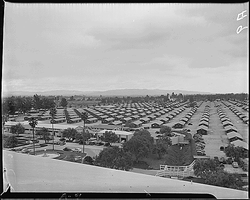As we settled into our bewildering lives at Santa Anita, clashing mess bells dictated our days. Clang, clang, ding, ding, bong, ka-ching—a mishmash of rhythms and tones rang out three times a day. In the evenings we surrendered ourselves to the block captain making bed-checks. The first few weeks he knocked and poked his head in and counted each of us, but later he simply tapped on the door and asked us to verify our number. “Yes, we’re here,” one of us would answer, but sometimes my father was missing. We wouldn’t have known what to say if he looked in and saw only three of us.
Monday was inspection day. We dragged our belongings outside onto the asphalt. Only beds remained inside. Sometimes, though, the police walked in and felt beneath the mattresses. They checked the goods spread on the street and confiscated anything on the contraband list, sometimes more. Radios and cameras were banned outright. A photographer with a studio in Nihonmachi had constructed a camera from found objects and hoped that his Caucasian assistant would bring him some lenses, but his partner had fled with all the equipment. Undaunted, he constructed a simple camera. A friend smuggled in film then returned to retrieve it and have it developed. The government banned photos that recorded life within the assembly centers, so the police desperately tried to find the camera before more photographs were taken. Soon they suspected everyone of sneaking in photographic materials. The police rifled through boxes, pillows, suitcases—sometimes even the pockets or the clothes we wore.
“Nanda, kore? What is this?” O-mi san toed the pajamas that I had folded into an imaginary sleeping figure, one sleeve tucked under the collar, legs bent at the knees.
“My pajamas, Mr. O-mi,” I said.
“ Don’t be smart,” he growled.
“What?”
“Do it right.”
“I don’t know...” I began before I glimpsed my mother’s warning glance.
“Yes, Mr. O-mi.” I picked up the pajamas and gathered them into a bundle.
When everything was hauled back into our room I folded my pajamas on my bed into another figure—arms raised in surrender, legs splayed.
“I give up, Mr. O-mi, O-mi-oni, O-mi-oni, Mr. O-ni devil,” I chanted and stretched my arms toward the ceiling.
“Mom, the white police don’t care how sloppy our stuff is. Why do the Japanese P.D.’s fuss so much?”
“I don’t know, but look, this time they took my sewing needles. Kanten sakana beetsu!”
“Mama!” My mother seldom used this fractured phrase. I told her we’d find new ones, but I didn’t know how. Some lucky people had “outside” friends bring them supplies—clothes, books, flashlights—but we weren’t one of those lucky ones. My parents had neither the time nor the know-how to make Caucasian friends. They worked for white people; they didn’t socialize with them.
“The police take anything they want.” My mother cried as she hit the wall with her fist.
“Do they really sell the stuff on the outside?” I asked.
“Who told you that?”
“Someone at school.”
“When Japanese take from other Japanese something is very wrong. Japanese always support each other. We must stand together.”
“That’s why people call them ‘inu,’” I said.
“Baka inu,” my mother emphasized.
The Issei were frugal. They ripped apart rice sacks and sewed them into underwear. They mended and re-mended sheets until they resembled patchwork. They took apart old dresses and transformed them into children’s clothes or pajamas. A few needles could do all of that. My mother told me how her mother made her count the number of pins and needles before she began a project, then re-count them before putting the project away. If a single pin were missing she had to find it before she could eat or go to bed.
Yes, a needle was a very precious thing, but the police didn’t care. They exerted their puffed up authority by taking needles.
Author’s note:
This is chapter 3 from an upcoming publication titled “18286.” The watercolors, photographs, and pictures which accompany each chapter, and are an integral part of the manuscript, are not included here. I have freely used dreams and imagination to augment lapses in memory, but the episodes are true. I have researched events and dates of historical events for accuracy.
© 2010 Lily Yuriko Nakai Havey







